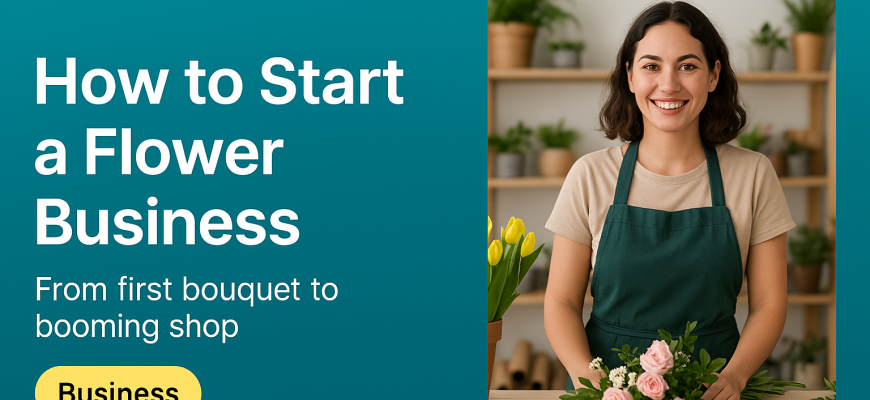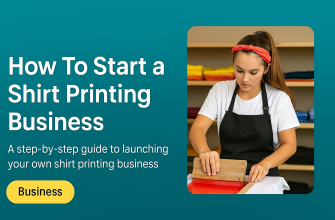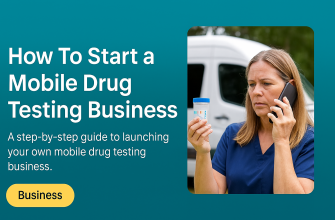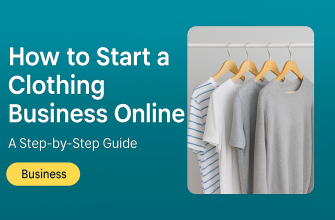Si alguna vez has soñado con convertir tu pasión por las flores en un negocio, este es el momento oportuno. Como señala Shopify, si tienes buena mano para las plantas y una chispa emprendedora, un negocio de flores podría ser la opción perfecta. Las cifras lo respaldan: las ventas de flores cortadas en EE. UU. aumentaron aproximadamente 1 millón de libras esterlinas (1,4 millones de dólares estadounidenses) entre 2017 y 2022, y se proyecta que la industria floral crezca entre 4 y 5 millones de libras esterlinas (1,5 millones de dólares estadounidenses) al año. Mejor aún, gran parte de la demanda proviene de mujeres: alrededor de 8 millones de libras esterlinas (1,4 millones de dólares estadounidenses) de flores son compradas por mujeres para otras mujeres. En resumen, como emprendedora, estás en una posición única para comprender a tus clientes y ayudar a que tu negocio prospere.
Cómo elegir su modelo de negocio
Hay tres formatos comunes para un negocio de flores. tiendas físicas Ofrece una tienda física donde los clientes puedan explorar los arreglos en persona. Este enfoque local te permite interactuar directamente con el cliente, pero requiere alquilar o comprar espacio y gestionar los gastos generales. Necesitarás una ubicación con buena afluencia de clientes y un presupuesto para el alquiler y los servicios públicos. Servicios de entrega en línea Le permite llegar a clientes de todo el país: concéntrese en crear un sitio web sólido y un envío confiable. Invierta en un sitio de comercio electrónico fácil de usar y fotos de alta calidad de sus ramos, y planifique una entrega puntual (local o por mensajería) para mantener las flores frescas. Finalmente, un modelo híbrido Combina ambos: por ejemplo, una tienda física que también acepta pedidos en línea o tiendas temporales que enlazan con tu tienda online. Sea cual sea el camino que elijas, primero investiga tu mercado. Como aconseja una guía, considera todos los tipos de floristerías, desde una floristería tradicional hasta una boutique online o un diseñador especializado en eventos, y elige el modelo que se adapte a tus fortalezas y a la demanda local.
-
Tienda física: Ideal para la visibilidad en la comunidad y las ventas directas. Busque zonas con buena afluencia de público (cerca de cafeterías, tiendas o mercados). Mantenga los gastos generales bajos y almacene las flores en las mejores condiciones (almacenamiento fresco y húmedo).
-
Servicio de entrega en línea: Ideal si quieres trabajar desde cualquier lugar. Céntrate en un sitio web impecable con SEO y colabora con un servicio de entrega confiable. Dado que las flores son perecederas, planifica rutas eficientes o contrata servicios de mensajería externos para garantizar la frescura a tiempo.
-
Modelo híbrido: Esto te permite diversificar. Puedes empezar con un estudio físico y también vender suscripciones o regalos online, o usar eventos temporales para atraer visitas online. Recuerda que tu modelo de negocio influirá en todo, desde el marketing hasta los precios.
Sentando las bases: planificación, licencias y finanzas
Toda empresa necesita un plan sólido y una base legal. Empieza por escribir un plan de negocios Esto abarca tu investigación de mercado, estrategia de precios y previsiones financieras. Calcula todos los costes (compras de flores al por mayor, jarrones, equipo de refrigeración e incluso el abono para flores) y determina cómo fijarás el precio de los arreglos florales para cubrir costes y beneficios. (Como regla general, los floristas suelen aspirar a un margen bruto de aproximadamente 60-70% en costes florales, ajustándolo según sea necesario a tus gastos). Identifica quiénes serán tus clientes (p. ej., novias, familias locales, clientes corporativos) y planifica estrategias de marketing para cada uno.
Siguiente, registre su empresa en cualquier forma legal que se ajuste a sus objetivos (empresa unipersonal, LLC, etc.). Probablemente necesitará una licencia comercial general y una permiso de vendedor Para recaudar el impuesto sobre las ventas minoristas. Si trabaja desde casa o tiene una tienda física, consulte las normas de zonificación locales o los permisos para negocios desde casa. (Afortunadamente, la floristería no requiere exámenes especiales para obtener una licencia; la mayoría de los requisitos son los mismos que para cualquier negocio minorista). Abra una cuenta bancaria comercial exclusiva para mantener sus finanzas en orden y obtenga el número de identificación fiscal federal (EIN) que necesite. En resumen: planifique con cuidado, regístrese correctamente y mantenga una buena contabilidad; esta base le permitirá centrarse en la creatividad más adelante.
Adquisición de flores y diseño de tu estilo
Tu negocio de flores necesita ambas cosas suministros y estiloEmpieza por encontrar proveedores de flores confiables. Muchos floristas establecen relaciones con floricultores y floricultores locales, lo que puede resultar en flores más frescas y menores costos. También puedes recurrir a mayoristas de confianza o incluso importar variedades exóticas, pero sea lo que sea que hagas, construir relaciones Para que obtengas calidad, consistencia y quizás descuentos a largo plazo. Siempre ten planes de contingencia: la estacionalidad y las cadenas de suministro pueden ser impredecibles, así que asegúrate de tener varias fuentes para tus variedades más populares.
La creatividad es tu arma secreta. Crea un estilo distintivo para tus ramos o arreglos: piensa en colores, recipientes únicos o técnicas especiales (flores secas, estilos de flores silvestres, suculentas, etc.). Crea un... portafolio de diseños Antes de abrir: crea ramos de muestra para diferentes ocasiones (cumpleaños, bodas, condolencias, festividades) y fotografíalos bien. Una buena iluminación es clave; Shopify incluso señala que las floristerías suelen diseñar sus estudios en torno a un lugar perfecto para las fotos. Usa estas imágenes en tu sitio web y redes sociales para mostrar tu estilo. En resumen, deja que tu creatividad brille, pero planifícalo metódicamente. Las fotos de alta calidad y una imagen de marca coherente atraerán a los clientes tanto como las propias flores.
Fijación de precios para obtener ganancias
Fijar tus precios con seguridad es crucial. Calcula todos los costos de cada arreglo: el precio al por mayor de las flores y los materiales, más la mano de obra (tu tiempo o el de tu personal), el empaque y los gastos generales. Luego, añade un margen de beneficio. (Como guía, muchos floristas buscan alrededor de un... Margen de beneficio 70% en flores y suministros; esto deja margen para gastos y ganancias). Recuerde incluir los costos del paquete, como cajas de regalo, papel de seda y jarrones. Piense también en términos de paquetes y paquetesPor ejemplo, combinar un ramo con chocolates o vino para San Valentín puede justificar un precio más alto y deleitar a los clientes. Ofrezca opciones por niveles (pequeño, mediano, de lujo) y paquetes de temporada (por ejemplo, un especial del Día de la Madre) y explique claramente por qué sus ofertas premium cuestan más (por ejemplo, flores más exclusivas, envoltorio de lujo).
Mantén la flexibilidad: presta atención a los precios de la competencia en tu zona y ajústalos según las festividades (los precios suelen subir cerca del Día de San Valentín o el Día de la Madre). Cobra lo que cobres, asegúrate de que cubra los costos y te compense por tu trabajo creativo. Como aconseja un experto en flores, no vendas solo flores; vende la experiencia y la calidad que las respaldan. Al contarles a tus clientes la historia de tus flores cuidadosamente seleccionadas o tu diseño único, sentirán que tus precios valen la pena.
Comercialización de su negocio de flores
Una vez que sus productos estén configurados, concéntrese en haciendo correr la vozUn sitio web atractivo es esencial: optimízalo para SEO para que los locales puedan encontrarte (por ejemplo, "floristería en [tu ciudad]"). Usa redes sociales como Instagram y Facebook para mostrar tus arreglos florales: recuerda que la floristería es un medio muy visual, así que prioriza tus imágenes. Publica con regularidad, interactúa con tus seguidores (quizás compartiendo videos de cómo se hacen los arreglos o consejos para el cuidado de tu floristería) y considera invertir en pequeños anuncios en línea dirigidos a clientes cercanos.
No olvides el marketing offline: colabora con organizadores de bodas, salones de eventos y negocios locales (hoteles, inmobiliarias, tiendas de artículos para fiestas). Las recomendaciones de estos socios pueden generar pedidos constantes. Por ejemplo, muchos floristas exitosos cultivan relaciones con organizadores de eventos para asegurar bodas y eventos corporativos. Ofrécete a hacer arreglos florales para eventos comunitarios o patrocina un evento benéfico para darte a conocer. Anima a tus clientes satisfechos a dejar reseñas online y considera un programa de fidelización para compradores recurrentes (por ejemplo, un ramo de flores gratis después de 10 compras). Con creatividad en tu marketing, al igual que en tus arreglos florales, destacarás.
Por fin, lanzar con un chapoteoOrganiza una gran inauguración o una promoción de lanzamiento en línea, como una oferta especial de ramo "compra uno y llévate otro a mitad de precio" o un taller de arreglos florales. Colabora con una cafetería o boutique local para un evento temporal. Como sugiere Shopify, los eventos temporales y las promociones de lanzamiento pueden generar entusiasmo y expectación. Cada paso de tu lanzamiento es una oportunidad para contar tu historia e inspirar a la gente, así que sé cercano y entusiasta.
De los pétalos a las ganancias
Emprender un negocio de flores combina arte y estrategia. Al elegir el formato adecuado (tienda, online o híbrido), cumplir con todos los requisitos legales y combinar la creatividad con una planificación sólida, sientas las bases para el éxito. Recuerda: muchos emprendedores como tú han transformado su pasión por las flores en negocios prósperos. Sigue aprendiendo sobre la marcha: únete a comunidades de floristas, asiste a talleres y perfecciona tu arte. Con cada ramo que vendas, ganarás experiencia.
YUNED Ten la visión y el impulso para lograrlo. Con un plan y tu creatividad a flor de piel, puedes construir un negocio de flores que no solo traiga alegría a tus clientes, sino que también haga florecer tus propios sueños.









